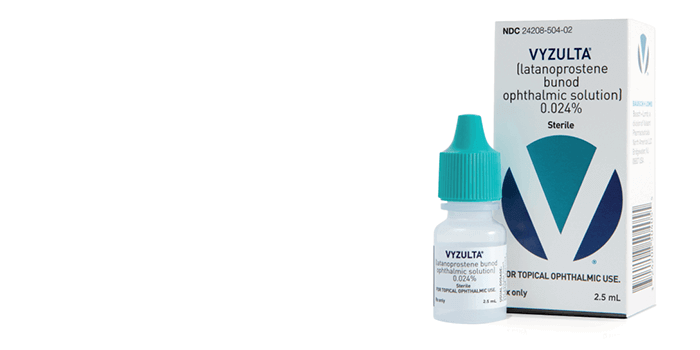Download article pdf
VYZULTA® (latanoprostene bunod ophthalmic solution) 0.024% is indicated for the reduction of intraocular pressure in patients with open-angle glaucoma or ocular hypertension.
VYZULTA is a single compound with a dual mechanism of action; working as a prostaglandin to increase aqueous humor outflow via the uveoscleral pathway, while also increasing trabecular meshwork outflow.
In the clinic
These days, I find myself prescribing VYZULTA more and more frequently as it has a favorable efficacy and similar side effect profile to latanoprost, as evidenced in a dose-ranging Phase II study (1). I typically use it for patients who need significant pressure-lowering – in many of my patients, I have seen a substantial reduction in pressure – which I can get in a single agent with VYZULTA.
I use VYZULTA in one of two ways. The most common scenario is as a first-line agent, which I am able to do more easily now than when it was originally approved, due to expanded healthcare coverage. The second scenario involves switching patients from another drug (such as latanoprost) to VYZULTA. In 40–50 percent of my patients, we see a substantial difference in pressure. Every millimeter counts in glaucoma; multiple studies have shown that every millimeter of mercury lowered can reduce the risk of disease progression (2,3).
Going with the flow
The mechanism of action of IOP-lowering medications is a big consideration for me – especially given my previous research on the trabecular meshwork as part of the Trabecular Meshwork Society. We now understand that the primary area of resistance in glaucoma is the trabecular meshwork. And so any drug that tackles outflow via the trabecular meshwork is of immediate interest.
In fact, Morton Grant, a key figure in ocular glaucoma, showed decades ago that outflow is primarily controlled by the trabecular meshwork, but for a long time we didn’t have well-tolerated drugs that directly addressed that pathway. Existing prostaglandin analogs (PGAs), including latanoprost, primarily target a secondary outflow mechanism – the uveoscleral pathway. Now we have another option.

Shan Lin, partner at the Glaucoma Center of San Francisco, CA, USA
Two mechanisms in one drop
VYZULTA is the first approved drug that targets both the uveoscleral pathway, with latanoprost, and the trabecular meshwork, with nitric oxide. Latanoprostene bunod is essentially latanoprost that has been chemically modified to include a nitric oxide-releasing component. When VYZULTA is introduced into the eye, it is enzymatically cleaved into latanoprost acid and butanediol mononitrate; the latter is further metabolized into nitric oxide, which relaxes the meshwork, allowing greater outflow. In short, by combining the standard PGA latanoprost and nitric oxide, we are able to target not one but two outflow mechanisms – the all-important dual action.
How does nitric oxide work? In brief, by activating the soluble guanylate cyclase-cyclic guanosine monophosphate cascade, which in turn reduces the contractility of the trabecular meshwork, leading to increased outflow and, ultimately, lowering pressure. In the lab, studies show that nitric oxide actually reduces contractility in cultured trabecular meshwork cells by inhibiting rho kinase and calcium signaling, two primary causes of cellular contraction (4, 5, 6). Interestingly, research shows that patients with primary open angle glaucoma are deficient in nitric oxide (7, 8, 9).
And though the chemistry and biology may not be of interest to everyone, the proven long-term safety and efficacy will be (10,11). I’ve now had extensive opportunities to use VYZULTA – and my overall impression is very positive.
Shan Lin is a consultant of Bausch + Lomb.
- Increased pigmentation of the iris and periorbital tissue (eyelid) can occur. Iris pigmentation is likely to be permanent
- Gradual changes to eyelashes, including increased length, increased thickness, and number of eyelashes, may occur. These changes are usually reversible upon treatment discontinuation
- Use with caution in patients with a history of intraocular inflammation (iritis/uveitis). VYZULTA should generally not be used in patients with active intraocular inflammation
- Macular edema, including cystoid macular edema, has been reported during treatment with prostaglandin analogs. Use with caution in aphakic patients, in pseudophakic patients with a torn posterior lens capsule, or in patients with known risk factors for macular edema
- There have been reports of bacterial keratitis associated with the use of multiple-dose containers of topical ophthalmic products that were inadvertently contaminated by patients
- Contact lenses should be removed prior to the administration of VYZULTA and may be reinserted 15 minutes after administration
- Most common ocular adverse reactions with incidence ≥2% are conjunctival hyperemia (6%), eye irritation (4%), eye pain (3%), and instillation site pain (2%)
Click here for full Prescribing Information
You are encouraged to report negative side effects of prescription drugs to the FDA. Visit www.fda.gov/medwatch or call 1-800-FDA-1088
Find out more: https://www.vyzultahcp.com/

VYZULTA and the V design are trademarks of Bausch & Lomb Incorporated or its affiliates
©2020 Bausch & Lomb Incorporated or its affiliates. All rights reserved – VYZ.0155.USA.20 – Date of preparation: December 2020
Click here for Making a Difference with VYZULTA®
References
- RN Weinreb et al., “A randomised, controlled comparison of latanoprostene bunod and latanoprost 0.005% in the treatment of ocular hypertension and open angle glaucoma: the VOYAGER study,” Br J Ophthalmol, 99, 738 (2014). PMID: 25488946.
- MC Leske et al., “Factors for glaucoma progression and the effect of treatment: the early manifest glaucoma trial,” Arch Ophthalmol, 121, 48 (2003). PMID: 12523884.
- A Heijl, “Glaucoma treatment: by the highest level of evidence,” Lancet, 385, 1264 (2015). PMID: 25533655.
- WM Dismuke et al., “Concentration-related effects of nitric oxide and endothelin-1 on human trabecular meshwork cell contractility,” Exp Eye Res, 120, 28 (2014). PMID: 24374036.
- A Schneemann et al., “Nitric oxide/guanylate cyclase pathways and flow in anterior segment perfusion,” Graefes Arch Clin Exp Ophthalmol, 240, 936 (2002). PMID: 12486517.
- M Wiederholt et al., “Relaxation of trabecular meshwork and ciliary muscle by release of nitric oxide,” Invest Ophthalmol Vis Sci 35, 2515 (1994). PMID: 7512945.
- S Doganay et al., “Decreased nitric oxide production in primary open-angle glaucoma,” Eur J Opthalmol, 12, 44 (2002). PMID: 11936443.
- F Galassi et al., “Nitric oxide proxies and ocular perfusion pressure in primary open angle glaucoma,” Br J Ophthalmol, 88, 757 (2004). PMID: 15148207.
- JA Nathanson, M McKee, “Alterations of ocular nitric oxide synthase in human glaucoma,” Invest Ophthalmol Vis Sci, 36, 1774 (1995). PMID: 7543463.
- K Kawase et al., “Long-term safety and efficacy of latanoprostene bunod 0.024% in Japanese subjects with open-angle glaucoma or ocular hypertension: The JUPITER Study”, Adv Ther, 33, 1612 (2016). PMID: 27457469.
- RN Weinreb et al., “Latanoprostene Bunod 0.024% in subjects with open-angle glaucoma or ocular hypertension: pooled phase 3 study findings,” J Glaucoma, 27, 7 (2018). PMID: 29194198.
